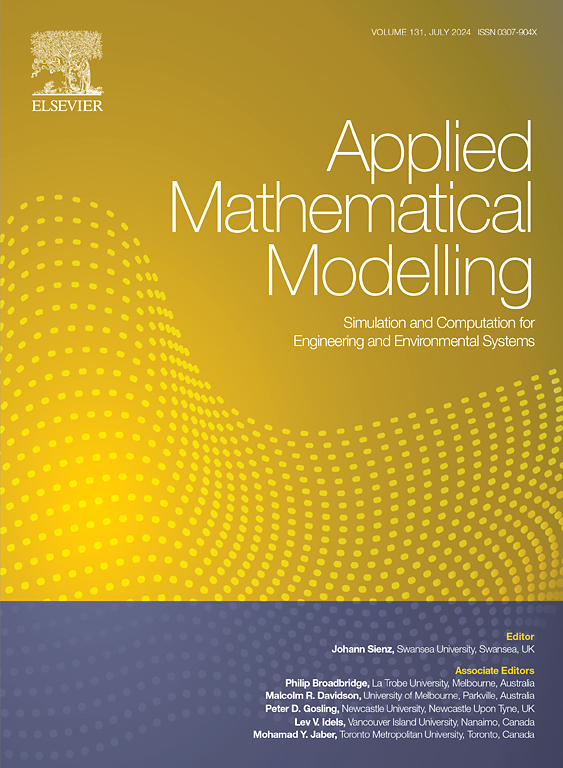用于约束机械系统动力学的新型变分积分器
IF 4.4
2区 工程技术
Q1 ENGINEERING, MULTIDISCIPLINARY
引用次数: 0
摘要
本文提出了一种新的变分积分器,用于求解约束机械系统。本积分器的主要特点来自基于汉密尔顿原理最一般形式的拉格朗日离散化。具体来说,离散位置采用 Hermite 插值法,这为广义坐标提供了至少 C1 的连续性。速度和动量采用二次多项式插值,以保证一致性,从而使速度和位置之间的运动学关系得到精确满足。同时,采用高斯-列根德正交法则来保证离散拉格朗日方程的精度。针对受约束的机械系统,采用坐标分割法消除约束方程。利用局部增量旋转向量来消除空间问题中的旋转奇异性。此外,还采用了自适应步长策略来提高效率。新积分器的优势在于可以在模拟中使用较大的步长,以及对位置和速度的全局二阶精度。为了验证其精度和能力,我们对几个实例进行了分析。本文章由计算机程序翻译,如有差异,请以英文原文为准。
A new variational integrator for constrained mechanical system dynamics
A new variational integrator is proposed to solve constrained mechanical systems. The main distinguishing feature of the present integrator comes from the distinct discretization of Lagrangians based on the Hamilton's principle in its most general form. Specifically, Hermite interpolation is used for discrete positions, which provides at least continuity for generalized coordinates. The velocities and momentums are interpolated using quadratic polynomials for the consistency, such that the kinematic relation between velocities and positions can be exactly satisfied. Meanwhile, the Gauss-Legendre quadrature rule is employed to guarantee the accuracy of discrete Lagrange equations. To tackle constrained mechanical systems, a coordinate partition approach is used to eliminate the constraint equations. The local incremental rotation vector is exploited to get rid of rotation singularities in spatial problems. Moreover, an adaptive stepsize strategy is implemented to improve the efficiency. The strengths of the new integrator lie in the accessible large step sizes in the simulation and its global second-order accuracy for positions as well as velocities. Several examples are performed and analyzed to validate its accuracy and capabilities.
求助全文
通过发布文献求助,成功后即可免费获取论文全文。
去求助
来源期刊

Applied Mathematical Modelling
数学-工程:综合
CiteScore
9.80
自引率
8.00%
发文量
508
审稿时长
43 days
期刊介绍:
Applied Mathematical Modelling focuses on research related to the mathematical modelling of engineering and environmental processes, manufacturing, and industrial systems. A significant emerging area of research activity involves multiphysics processes, and contributions in this area are particularly encouraged.
This influential publication covers a wide spectrum of subjects including heat transfer, fluid mechanics, CFD, and transport phenomena; solid mechanics and mechanics of metals; electromagnets and MHD; reliability modelling and system optimization; finite volume, finite element, and boundary element procedures; modelling of inventory, industrial, manufacturing and logistics systems for viable decision making; civil engineering systems and structures; mineral and energy resources; relevant software engineering issues associated with CAD and CAE; and materials and metallurgical engineering.
Applied Mathematical Modelling is primarily interested in papers developing increased insights into real-world problems through novel mathematical modelling, novel applications or a combination of these. Papers employing existing numerical techniques must demonstrate sufficient novelty in the solution of practical problems. Papers on fuzzy logic in decision-making or purely financial mathematics are normally not considered. Research on fractional differential equations, bifurcation, and numerical methods needs to include practical examples. Population dynamics must solve realistic scenarios. Papers in the area of logistics and business modelling should demonstrate meaningful managerial insight. Submissions with no real-world application will not be considered.
 求助内容:
求助内容: 应助结果提醒方式:
应助结果提醒方式:


